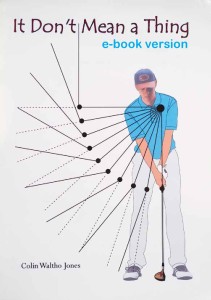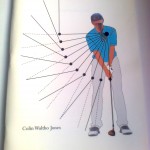Extracts from my first letter to John.
24th February 2011
Dear John,
A few things:
1. Thanks. It was a real pleasure for me to be able to share these ideas again. Although my Dad was a practitioner, he never really engaged in the theory as such because he was terrified that if he over-analysed then the “magic” would leave him; as, occasionally, it did anyway. When it did, I would take him back to first principles and it would return easily enough. It only left him a few times and it was always because he had “fiddled” one too many times. But, “fiddling” is a natural side-effect of the theory and for a very important reason:
As you relax and let go of the idea that you can consciously “hit” the ball accurately then so your pendulums will synchronise more and more. When you get to this stage, you know because it feels like it takes ages to get through the hitting area, which in turn gives you the feeling of being able to consciously manipulate what happens in the hitting area. And, guess what? – you can! When you get to this point, then virtually anything is possible. However, the feeling of control is so overwhelmingly attractive that the player (ie my Dad) is lured into attempting conscious manipulation earlier and earlier in the swing; and before you know where you are your “timing” has disappeared and the ball is clanking of the club-face like a ball-bearing off a frying pan. The cure is to go back to simple non-manipulation, “timing” returns immediately, and before long you are back to spending a long time in the hitting area and feeling as if you can attempt some conscious control again.
It is important that you have “conscious control” as an ultimate aim because it is where the real “fun” is. But, it is just as important to be aware of the pitfalls of forcing conscious control rather than waiting for it to be presented as an opportunity.
3. You. I just want to say thank you for listening and for contributing intelligently. I acknowledge that asking me to tell you about something sporting is a big thing; you are steeped in a sporting and cultural history, and have had plenty of success. It takes a certain humility and openness of mind to be able to take advice from someone like me.
6. Bad shots. The brilliant advantage of this method over any other is that bad shots will not have the corrosive effect they may have had in the past. In the Bell South Classic in 1967, Jack Nicklaus shanked a five-iron fifty yards into the rough on the 15th in the last round. He went birdie, eagle, birdie to win the tournament. When asked about the shank he replied that he had been annoyed but that by the time he had reached the ball to play the next shot he could only think about what needed doing.
With this method you are only ever looking for the rhythm. When you hit a bad shot there will be enough time before the next shot to remind yourself that a bad shot is just a mis-timed shot and you just need to find that rhythm that guarantees “timing”. However, the real advantage of this is that it enables you to play with freedom because you will not be afraid that a bad shot is going to spoil the round by throwing you off course. You have access to “timing” at all times and so can play with a real imaginative (and physical) freedom. A shot that doesn’t come off will feel just that – a shot that didn’t come off! So what! What’s the next shot?
7. Good shots. Having fun is attempting perfection ie if the shot wasn’t perfect it was still fun trying. This attitude means that there is no sense of being satisfied or dissatisfied with the outcome of a shot – unless it is perfect, then you can allow yourself a smug grin. No shot less than perfect is “good enough”. It means nothing more than the shot was less than perfect. So what? What’s the next shot?
Regards,
Colin


